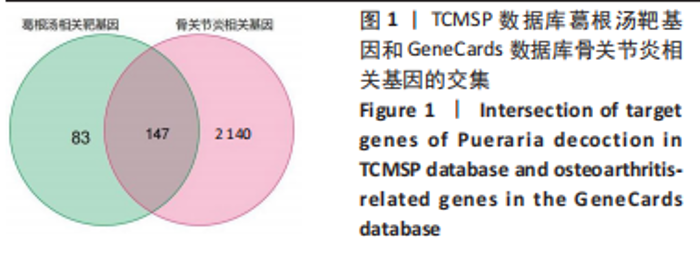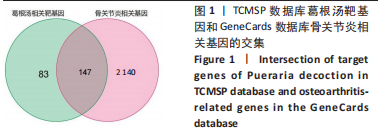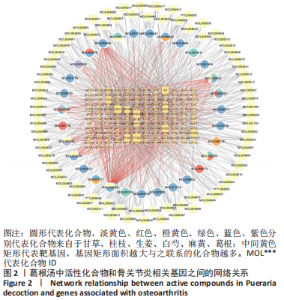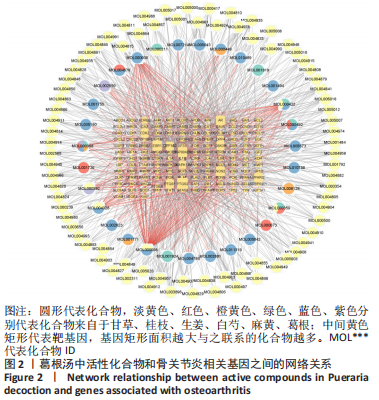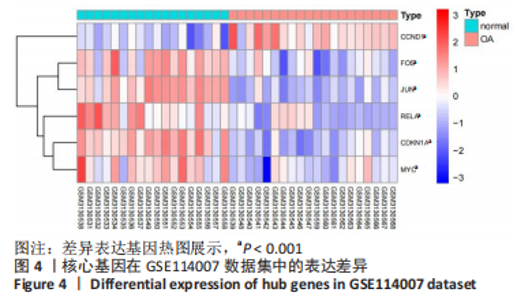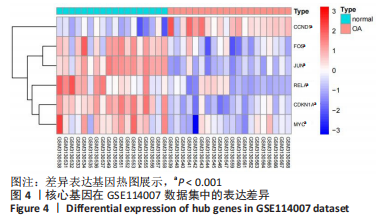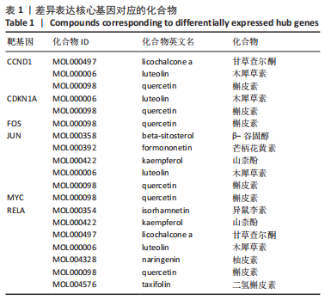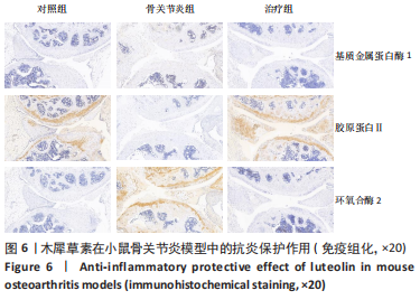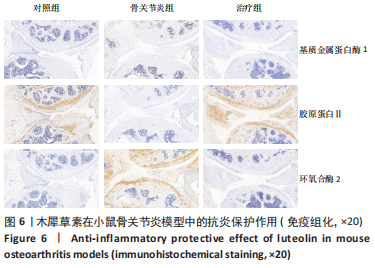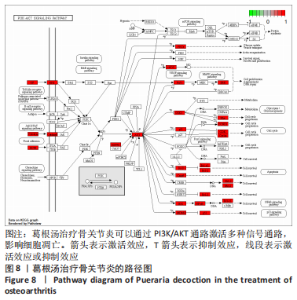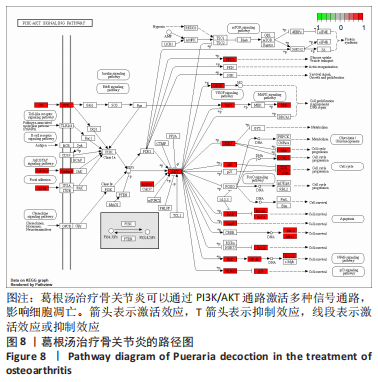Chinese Journal of Tissue Engineering Research ›› 2024, Vol. 28 ›› Issue (2): 193-199.doi: 10.12307/2023.996
Previous Articles Next Articles
Pueraria decoction in the treatment of osteoarthritis: network pharmacology analysis and animal model validation
Liu Baofang1, Xu Bin1, Chen Lei2
- 1Department of Orthopedics, the First Affiliated Hospital of Anhui Medical University, Hefei 230001, Anhui Province, China; 2Department of Burns and Plastic Surgery, the First Affiliated Hospital of Wannan Medical College, Wuhu 241000, Anhui Province, China
-
Received:2022-11-22Accepted:2023-02-24Online:2024-01-18Published:2023-06-29 -
Contact:Xu Bin, Master, Chief physician, Doctoral supervisor, Department of Orthopedics, the First Affiliated Hospital of Anhui Medical University, Hefei 230001, Anhui Province, China -
About author:Liu Baofang, Master candidate, Department of Orthopedics, the First Affiliated Hospital of Anhui Medical University, Hefei 230001, Anhui Province, China -
Supported by:the Natural Science Foundation of Anhui Province, No. 1808085MH243 (to XB); Science and Technology Plan of Wuhu City, No. 2021jc2-4 (to CL)
CLC Number:
Cite this article
Liu Baofang, Xu Bin, Chen Lei. Pueraria decoction in the treatment of osteoarthritis: network pharmacology analysis and animal model validation[J]. Chinese Journal of Tissue Engineering Research, 2024, 28(2): 193-199.
share this article
Add to citation manager EndNote|Reference Manager|ProCite|BibTeX|RefWorks
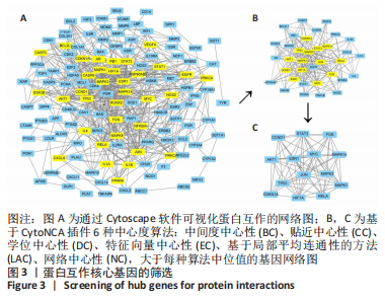
2.3 蛋白互作网络和核心基因的鉴定 通过将靶点基因上传至STRING数据库,可获得靶点基因对应的蛋白互作网络,并将此网络导入Cytoscape软件可视化,根据Cytoscape插件CytoNCA分别计算网络节点的拓扑参数:中间度中心性、贴近中心性、学位中心性、特征向量中心性、基于局部平均连通性的方法、网络中心性,先后根据各个参数数值的中位数运算筛选核心基因2次,运算值域分别为大于6个运算值参数的中位数。最终获得14个核心基因,分别为MAPK1、MAPK14、AKT1、STAT3、FOS、JUN、CDKN1A、ESR1、MAPK3、CCND1、TP53、MYC、RELA、HIF1A,见图3。"
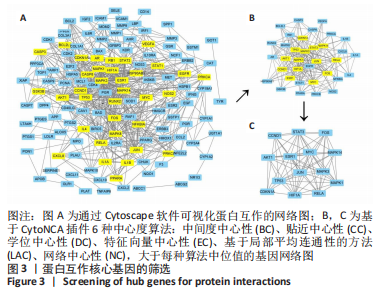
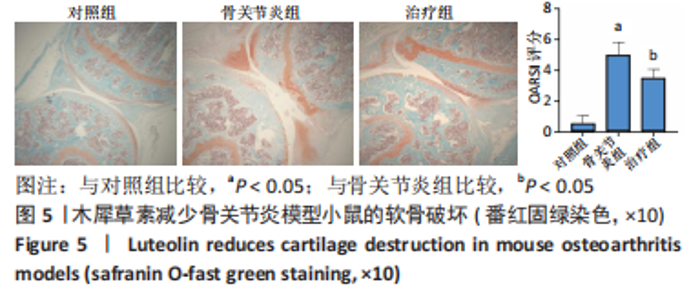
2.5 动物实验验证 在多项研究中已经充分证明槲皮素有治疗骨关节炎的效果,此次实验选取了对差异表达核心基因作用较多的化合物木犀草素作为实验研究对象。通过动物实验验证木犀草素治疗骨关节炎的作用,番红固绿染色显示,对照组软骨表面完整光滑,软骨胶原和软骨结构完整;骨关节炎组软骨表面粗糙,结构破坏严重,软骨胶原丢失较多,软骨基质染色减少;与骨关节炎组比较,治疗组软骨表面相对平整,结构破坏相对减轻,软骨胶原丢失较少,软骨基质染色相对较好,见图5。通过骨关节炎小鼠模型免疫组化实验评价木犀草素在骨关节炎中的抗炎作用,结果显示:与骨关节炎组相比,治疗组的基质金属蛋白酶1和环氧合酶2表达明显减少,胶原蛋白Ⅱ明显增加。总的来说,这些实验表明木犀草素在动物体内具有保护作用,见图6。"
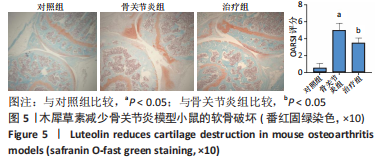
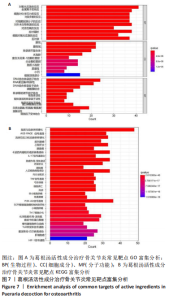
2.6 靶基因的功能分析 此次实验根据R语言“ClusterProfiler包”分析靶基因在GO功能上的主要富集,生物过程包括对氧化应激的反应、金属离子的响应、细胞对化学压力的反应、对脂多糖的反应、对活性氧的反应、细胞对氧化应激的反应;细胞成分包括膜筏、膜微域、转录调节复合体、胞质小泡腔等;分子功能包括DNA结合转录因子结合、RNA聚合酶Ⅱ特异性DNA结合转录因子结合、转录因子的调节、氨基酸的代谢等功能上,见图7A。KEGG功能富集主要有:糖尿病并发症中的AGE-RAGE信号通路、白细胞介素17信号通路、肿瘤坏死因子α信号通路、PI3K/Akt信号通路、Toll样受体信号通路、HIF-1信号通路等,见图7B,其中葛根汤治疗骨关节炎的36个靶基因主要富集在PI3K/Akt信号通路上,6个差异核心基因中有3个富集在此通路上,见图8。"
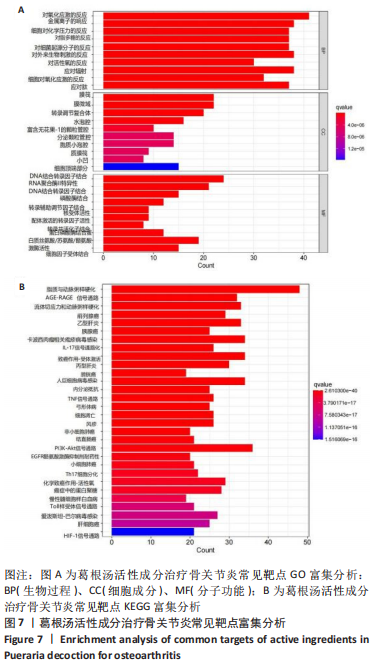
| [1] EMERY CA, WHITTAKER JL, MAHMOUDIAN A, et al. Establishing outcome measures in early knee osteoarthritis. Nat Rev Rheumatol. 2019;15(7):438-448. [2] XIONG Y, MI BB, LIU MF, et al. Bioinformatics Analysis and Identification of Genes and Molecular Pathways Involved in Synovial Inflammation in Rheumatoid Arthritis. Med Sci Monit. 2019;25:2246-2256. [3] COHEN SP, VASE L, HOOTEN WM. Chronic pain: an update on burden, best practices, and new advances. Lancet. 2021;397(10289):2082-2097. [4] CHEN S, CHEN M, WU X, et al. Global, regional and national burden of low back pain 1990-2019: A systematic analysis of the Global Burden of Disease study 2019. J Orthop Translat. 2021;32:49-58. [5] MILLER RJ, MALFAIT AM, MILLER RE. The innate immune response as a mediator of osteoarthritis pain. Osteoarthritis Cartilage. 2020;28(5):562-571. [6] YOU R, LIU S, TAN J. Screening and identification of osteoarthritis related differential genes and construction of a risk prognosis model based on bioinformatics analysis. Ann Transl Med. 2022;10(8):444. [7] SAFIRI S, KOLAHI AA, SMITH E, et al. Global, regional and national burden of osteoarthritis 1990-2017: a systematic analysis of the Global Burden of Disease Study 2017. Ann Rheum Dis. 2020;79(6):819-828. [8] LU K, MA F, YI D, et al. Molecular signaling in temporomandibular joint osteoarthritis. J Orthop Translat. 2021;32:21-27. [9] VINCENT TL. Targeting mechanotransduction pathways in osteoarthritis: a focus on the pericellular matrix. Curr Opin Pharmacol. 2013;13(3):449-454. [10] SHEN S, WU Y, CHEN J, et al. CircSERPINE2 protects against osteoarthritis by targeting miR-1271 and ETS-related gene. Ann Rheum Dis. 2019;78(6):826-836. [11] SCHULZE-TANZIL G. Intraarticular Ligament Degeneration Is Interrelated with Cartilage and Bone Destruction in Osteoarthritis. Cells. 2019;8(9):990. [12] MEDVEDEVA EV, GREBENIK EA, GORNOSTAEVA SN, et al. Repair of Damaged Articular Cartilage: Current Approaches and Future Directions. Int J Mol Sci. 2018; 19(8):2366. [13] BHOSALE AM, RICHARDSON JB. Articular cartilage: structure, injuries and review of management. Br Med Bull. 2008;87:77-95. [14] JEON OH, KIM C, LABERGE RM, et al. Local clearance of senescent cells attenuates the development of post-traumatic osteoarthritis and creates a pro-regenerative environment. Nat Med. 2017;23(6):775-781. [15] IOLASCON G, GIMÉNEZ S, MOGYORÓSI D. A Review of Aceclofenac: Analgesic and Anti-Inflammatory Effects on Musculoskeletal Disorders. J Pain Res. 2021;14: 3651-3663. [16] WONG G. Pharmacological management of chronic non-cancer pain in frail older people. Aust Prescr. 2022;45(1):2-7. [17] 周军,方素萍,齐云霍,等.葛根汤对大鼠佐剂性关节炎防治作用研究[J].中国实验方剂学杂志,2001,7(2):29-30,38. [18] RU J, LI P, WANG J, et al. TCMSP: a database of systems pharmacology for drug discovery from herbal medicines. J Cheminform. 2014;6:13. [19] LIN Z, ZHANG Z, YE X, et al. Based on network pharmacology and molecular docking to predict the mechanism of Huangqi in the treatment of castration-resistant prostate cancer. PLoS One. 2022;17(5):e0263291. [20] LIU T, SHAO Q, WANG W, et al. Integrating network pharmacology and experimental validation to decipher the mechanism of the Chinese herbal prescription JieZe-1 in protecting against HSV-2 infection. Pharm Biol. 2022;60(1): 451-466. [21] WU Z, LI W, LIU G, et al. Network-Based Methods for Prediction of Drug-Target Interactions. Front Pharmacol. 2018;9:1134. [22] KONG Y, MA X, ZHANG X, et al. The potential mechanism of Fructus Ligustri Lucidi promoting osteogenetic differentiation of bone marrow mesenchymal stem cells based on network pharmacology, molecular docking and experimental identification. Bioengineered. 2022;13(4):10640-10653. [23] LIU S, ZHANG Q, LIU W, et al. Research on the mechanisms of Shu Yu wan in the treatment of cervical cancer based on network pharmacology analyses and molecular docking technology. Nat Prod Res. 2023;37(4):646-650. [24] CHU M, GAO T, ZHANG X, et al. Elucidation of Potential Targets of San-Miao-San in the Treatment of Osteoarthritis Based on Network Pharmacology and Molecular Docking Analysis. Evid Based Complement Alternat Med. 2022;2022:7663212. [25] CHEN P, ZHOU J, RUAN A, et al. Cinnamic Aldehyde, the main monomer component of Cinnamon, exhibits anti-inflammatory property in OA synovial fibroblasts via TLR4/MyD88 pathway. J Cell Mol Med. 2022;26(3):913-924. [26] GOYAL A, AGRAWAL N. Quercetin: A Potential Candidate for the Treatment of Arthritis. Curr Mol Med. 2022;22(4):325-335. [27] WANG XP, XIE WP, BI YF, et al. Quercetin suppresses apoptosis of chondrocytes induced by IL-1β via inactivation of p38 MAPK signaling pathway. Exp Ther Med. 2021;21(5):468. [28] TSAI SW, LIN CC, LIN SC, et al. Isorhamnetin ameliorates inflammatory responses and articular cartilage damage in the rats of monosodium iodoacetate-induced osteoarthritis. Immunopharmacol Immunotoxicol. 2019;41(4):504-512. [29] LO S, LEUNG E, FEDRIZZI B, et al. Syntheses of mono-acylated luteolin derivatives, evaluation of their antiproliferative and radical scavenging activities and implications on their oral bioavailability. Sci Rep. 2021;11(1):12595. [30] XIE K, CHAI YS, LIN SH, et al. Luteolin Regulates the Differentiation of Regulatory T Cells and Activates IL-10-Dependent Macrophage Polarization against Acute Lung Injury. J Immunol Res. 2021;2021:8883962. [31] JIA T, QIAO J, GUAN D, et al. Anti-Inflammatory Effects of Licochalcone A on IL-1β-Stimulated Human Osteoarthritis Chondrocytes. Inflammation. 2017;40(6):1894-1902. [32] HUANG X, PAN Q, MAO Z, et al. Kaempferol inhibits interleukin‑1β stimulated matrix metalloproteinases by suppressing the MAPK‑associated ERK and P38 signaling pathways. Mol Med Rep. 2018;18(3):2697-2704. [33] GAUR R, MENSAH KA, STRICKER J, et al. CC-99677, a novel, oral, selective covalent MK2 inhibitor, sustainably reduces pro-inflammatory cytokine production. Arthritis Res Ther. 2022;24(1):199. [34] MIMPEN JY, BALDWIN MJ, CRIBBS AP, et al. Interleukin-17A Causes Osteoarthritis-Like Transcriptional Changes in Human Osteoarthritis-Derived Chondrocytes and Synovial Fibroblasts In Vitro. Front Immunol. 2021;12:676173. [35] AMATYA N, GARG AV, GAFFEN SL. IL-17 Signaling: The Yin and the Yang. Trends Immunol. 2017;38(5):310-322. [36] SNELLING SJ, BAS S, PUSKAS GJ, et al. Presence of IL-17 in synovial fluid identifies a potential inflammatory osteoarthritic phenotype. PLoS One. 2017;12(4):e0175109. [37] ZHANG K, LI Z, LU Y, et al. Silencing of Vangl2 attenuates the inflammation promoted by Wnt5a via MAPK and NF-κB pathway in chondrocytes. J Orthop Surg Res. 2021;16(1):136. [38] LU J, ZHANG H, PAN J, et al. Fargesin ameliorates osteoarthritis via macrophage reprogramming by downregulating MAPK and NF-κB pathways. Arthritis Res Ther. 2021;23(1):142. [39] BARRETO G, MANNINEN M, EKLUND KK. Osteoarthritis and Toll-Like Receptors: When Innate Immunity Meets Chondrocyte Apoptosis. Biology (Basel). 2020;9(4):65. [40] WON Y, YANG JI, PARK S, et al. Lipopolysaccharide Binding Protein and CD14, Cofactors of Toll-like Receptors, Are Essential for Low-Grade Inflammation-Induced Exacerbation of Cartilage Damage in Mouse Models of Posttraumatic Osteoarthritis. Arthritis Rheumatol. 2021;73(8):1451-1460. [41] QI W, CHEN Y, SUN S, et al. Inhibiting TLR4 signaling by linarin for preventing inflammatory response in osteoarthritis. Aging (Albany NY). 2021;13(4):5369-5382. [42] FERNÁNDEZ-TORRES J, ZAMUDIO-CUEVAS Y, MARTÍNEZ-NAVA GA, et al. Hypoxia-Inducible Factors (HIFs) in the articular cartilage: a systematic review. Eur Rev Med Pharmacol Sci. 2017;21(12):2800-2810. [43] BOUAZIZ W, SIGAUX J, MODROWSKI D, et al. Interaction of HIF1α and β-catenin inhibits matrix metalloproteinase 13 expression and prevents cartilage damage in mice. Proc Natl Acad Sci U S A. 2016;113(19):5453-5458. [44] HAN M, LIN J, YANG Y, et al. Xinshuaining preparation protects H9c2 cells from H2O2-induced oxidative damage through the PI3K/Akt/Nrf-2 signaling pathway. Clin Exp Hypertens. 2022:1-9. doi: 10.1080/10641963.2022.2131806. [45] LI W, MAO Y, HUA B, et al. Sasanquasaponin inhibited epithelial to mesenchymal transition in prostate cancer by regulating the PI3K/Akt/mTOR and Smad pathways. Pharm Biol. 2022;60(1):1865-1875. [46] MEHRA S, SRINIVASAN S, SINGH S, et al. Urolithin A attenuates severity of chronic pancreatitis associated with continued alcohol intake by inhibiting PI3K/AKT/mTOR signaling. Am J Physiol Gastrointest Liver Physiol. 2022;323(4):G375-G386. [47] CHEN P, WU S, DONG X, et al. Formosanin C induces autophagy-mediated apoptosis in multiple myeloma cells through the PI3K/AKT/mTOR signaling pathway. Hematology. 2022;27(1):977-986. [48] JIANG Y, XIE Z, YU J, et al. Resveratrol inhibits IL-1β-mediated nucleus pulposus cell apoptosis through regulating the PI3K/Akt pathway. Biosci Rep. 2019;39(3): BSR20190043. [49] PARK C, JEONG JW, LEE DS, et al. Sargassum serratifolium Extract Attenuates Interleukin-1β-Induced Oxidative Stress and Inflammatory Response in Chondrocytes by Suppressing the Activation of NF-κB, p38 MAPK, and PI3K/Akt. Int J Mol Sci. 2018;19(8):2308. [50] ZHANG XF, MA JX, WANG YL, et al. Calcyclin (S100A6) Attenuates Inflammatory Response and Mediates Apoptosis of Chondrocytes in Osteoarthritis via the PI3K/AKT Pathway. Orthop Surg. 2021;13(3):1094-1101. [51] TONG KM, SHIEH DC, CHEN CP, et al. Leptin induces IL-8 expression via leptin receptor, IRS-1, PI3K, Akt cascade and promotion of NF-kappaB/p300 binding in human synovial fibroblasts. Cell Signal. 2008;20(8):1478-1488. |
| [1] | Guo Xiangying, Peng Zifu, He Yimin, Fang Hongbo, Jiang Ning. MiRNA-122 contributes to the effect of exercise on non-alcoholic fatty liver [J]. Chinese Journal of Tissue Engineering Research, 2024, 28(2): 272-279. |
| [2] | Ran Lei, Han Haihui, Xu Bo, Wang Jianye, Shen Jun, Xiao Lianbo, Shi Qi. Molecular docking analysis of the anti-inflammatory mechanism of Cibotium barometz and Epimedium for rheumatoid arthritis: animal experiment validation [J]. Chinese Journal of Tissue Engineering Research, 2024, 28(2): 208-215. |
| [3] | Zuo Jun, Ma Shaolin. Mechanism of beta-sitosterol on hypertrophic scar fibroblasts: an analysis based on network pharmacology [J]. Chinese Journal of Tissue Engineering Research, 2024, 28(2): 216-223. |
| [4] | Yang Ting, Ding Zhibin, Jiang Nan, Han Hongxia, Hou Miaomiao, Ma Cungen, Song Lijuan, Li Xinyi. Astrocytes regulate glial scar formation in cerebral ischemic stroke [J]. Chinese Journal of Tissue Engineering Research, 2024, 28(1): 131-138. |
| [5] | Wang Xianfeng, Wang Kun, Sun Han, Sun Xiaoliang, Yan Litao. Mechanism underlying exosomal lncRNA H19 derived from umbilical cord mesenchymal stem cells promotes cartilage injury repair [J]. Chinese Journal of Tissue Engineering Research, 2024, 28(1): 20-25. |
| [6] | Zhang Li, Yang Wenjun, Sang Xiaohong, Han Yuanyuan, Mao Zhijie, Wang Shun, Lu Chen. Effect of overexpression of protein phosphatase 2Cm on transcriptome of human renal tubular epithelial cells [J]. Chinese Journal of Tissue Engineering Research, 2024, 28(1): 68-73. |
| [7] | Shen Feiyan, Yao Jixiang, Su Shanshan, Zhao Zhongmin, Tang Weidong. Knockdown of circRNA WD repeat containing protein 1 inhibits proliferation and induces apoptosis of chondrocytes in knee osteoarthritis [J]. Chinese Journal of Tissue Engineering Research, 2023, 27(在线): 1-6. |
| [8] | Li Xiaomin, Tian Xiangdong, Tan Yetong, Zhu Guangyu, Wang Rongtian, Wang Jian, Xue Zhipeng, Ma Sheng, Hu Yuanyi, Huang Ye, Ding Tiansong. Changes of lower limb force line and knee function after high tibial osteotomy in osteoporotic medial ventricular knee osteoarthritis [J]. Chinese Journal of Tissue Engineering Research, 2023, 27(9): 1325-1329. |
| [9] | Huang Linke, Wei Linhua, Jiang Jie, Liu Qian, Chen Weiwei. Effects of estrogen combined with treadmill exercise on bone mass and articular cartilage in ovariectomized mice [J]. Chinese Journal of Tissue Engineering Research, 2023, 27(8): 1166-1171. |
| [10] | Zhao Lu, Zhao Yifei, Gao Da, Liu Yanfang, Fu Tingting, Xu Jiangyan. Expression of suppressor of Zeste 12 in kidney tissues of rats with diabetic nephropathy [J]. Chinese Journal of Tissue Engineering Research, 2023, 27(8): 1179-1186. |
| [11] | Li Xinyue, Li Xiheng, Mao Tianjiao, Tang Liang, Li Jiang. Three-dimensional culture affects morphology, activity and osteogenic differentiation of human periodontal ligament stem cells [J]. Chinese Journal of Tissue Engineering Research, 2023, 27(6): 846-852. |
| [12] | Yuan Wei, Liu Jingdong, Xu Guanghui, Kang Jian, Li Fuping, Wang Yingjie, Zhi Zhongzheng, Li Guanwu. Osteogenic differentiation of human perivascular stem cells and its regulation based on Wnt/beta-catenin signaling pathway [J]. Chinese Journal of Tissue Engineering Research, 2023, 27(6): 866-871. |
| [13] | Yuan Bo, Xie Lide, Fu Xiumei. Schwann cell-derived exosomes promote the repair and regeneration of injured peripheral nerves [J]. Chinese Journal of Tissue Engineering Research, 2023, 27(6): 935-940. |
| [14] | Wang Jinling, Huang Xiarong, Qu Mengjian, Huang Fujin, Yin Lingwei, Zhong Peirui, Liu Jin, Sun Guanghua, Liao Yang, Zhou Jun. Effects of exercise training on bone mass and bone microstructure in aged osteoporotic rats [J]. Chinese Journal of Tissue Engineering Research, 2023, 27(5): 676-682. |
| [15] | Yuan Changshen, Guan Yanbing, Li Zhe, Rong Weiming, Liao Shuning, Chen Lewei, Mei Qijie, Duan Kan. Screening and verification of key genes of necroptosis in osteoarthritis [J]. Chinese Journal of Tissue Engineering Research, 2023, 27(5): 695-700. |
| Viewed | ||||||
|
Full text |
|
|||||
|
Abstract |
|
|||||
